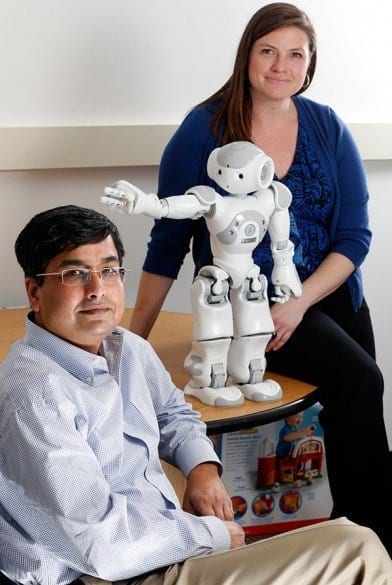
“The children’s engagement with the robot was excellent,” Crittendon said, “and we saw improvements across the board in both groups.”
“Aiden, look!” piped NAO, a two-foot tall humanoid robot, as it pointed to a flat-panel display on a far wall. As the cartoon dog Scooby Doo flashed on the screen, Aiden, a young boy with an unruly thatch of straw-colored hair, looked in the direction the robot was pointing.
Aiden, who is three and a half years old, has been diagnosed with autism spectrum disorder (ASD). NAO (pronounced “now”) is the diminutive “front man” for an elaborate system of cameras, sensors and computers designed specifically to help children like Aiden learn how to coordinate their attention with other people and objects in their environment. This basic social skill is called joint attention. Typically developing children learn it naturally. Children with autism, however, have difficulty mastering it and that inability can compound into a variety of learning difficulties as they age.
An interdisciplinary team of mechanical engineers and autism experts at Vanderbilt University have developed the system and used it to demonstrate that robotic systems may be powerful tools for enhancing the basic social learning skills of children with ASD. Writing in the March issue of the IEEE Transactions on Neural Systems and Rehabilitation Engineering, the researchers report that children with ASD paid more attention to the robot and followed its instructions almost as well as they did those of a human therapist in standard exercises used to develop joint attention skill.
The finding indicates that robots could play a crucial role in responding to the “public health emergency” that has been created by the rapid growth in the number of children being diagnosed with ASD. Today, one in 88 children (one in 54 boys) are being diagnosed with ASD. That is a 78 percent increase in just four years. The trend has major implications for the nation’s healthcare budget because estimates of the lifetime cost of treating ASD patients ranges from four to six times greater than for patients without autism.
“This is the first real world test of whether intelligent adaptive systems can make an impact on autism,” said team member Zachary Warren, who directs the Treatment and Research Institute for Autism Spectrum Disorders (TRIAD) at Vanderbilt’s Kennedy Center.
The Latest Bing News on:
Humanoid robot helps train children with autism
- Oklahoma Pediatrician Dr. Hokehe Eko, Launches Virtual Clinic To Evaluate Children With Autismon April 18, 2024 at 5:00 pm
The virtual ADHD and autism evaluations are currently accessible in Oklahoma, Georgia, and Maryland for children 18 months ... and can also help identify if there are other factors at play ...
- ‘No child is left behind’: Mother, advocate provides resources for Somali American children with disabilitieson April 18, 2024 at 6:54 am
They were at a 7-12 school in Dorchester, learning how to use a communication tablet designed to help children with disabilities — like Nasteho, who has autism and is nonverbal — communicate ...
- Boston Dynamics' robot Atlas being billed as 'fully-electric humanoid': Watch it in actionon April 18, 2024 at 5:15 am
This humanoid is famously known for its groovy dance moves that went viral in 2020. Creating a robot that has similar features to a human will help the robot navigate our world easier, Boston ...
- Best Car Toys for Kids with Autismon April 17, 2024 at 5:00 pm
Since 2013 the presence of sensory sensitivities has been used to help diagnose autism. Research has suggested that sensory-focused toys can provide children with a way to develop their senses in ...
- Children with autism get chance to flourishon April 15, 2024 at 11:30 pm
"Guan advised me to establish an institution in Guizhou where children with autism could learn locally, and where their parents could help one another. She would act as a volunteer, offering ...
- Autism doesn’t discriminate. Autism research shouldn’t eitheron April 15, 2024 at 5:00 pm
In it, one in 10 parents said they delayed seeking an evaluation for their child because they simply did not know enough about autism and its signs. When Black parents did seek help, they often ...
- Apollo the robot joins Mercedes-Benz assembly line productionon April 13, 2024 at 2:59 am
And guess what? The solution seems to be robots. At Mercedes-Benz Manufacturing in Hungary, they’ve swapped out some of their human workers for humanoid robots right there on the factory floor.
- How blue-collar workers will train the humanoids that take their jobson April 9, 2024 at 5:00 pm
Carnegie Mellon University (CMU) researchers have developed H2O – Human2HumanOid – a reinforcement learning-based framework that allows a full-sized humanoid ... help but wonder if that’s ...
- ‘Yelling demands’ at humanoid robots helps them learn and increases success by 20% as AI bot taught to ‘serve humans’on April 2, 2024 at 4:53 pm
YELLING commands at humanoid robots could help them learn more efficiently ... Right now, there are several different methods used to train robots. It's common to input commands or teleoperate ...
- A robot that helps children in need of assistance walkon March 28, 2024 at 5:00 pm
Trexo Robotics created a robot aid that helps children walk. The system moves your legs and feet to imitate the walking movement. When the bottom of the feet makes contact with the surface of the ...
The Latest Google Headlines on:
Humanoid robot helps train children with autism
[google_news title=”” keyword=”Humanoid robot helps train children with autism” num_posts=”10″ blurb_length=”0″ show_thumb=”left”] [/vc_column_text]The Latest Bing News on:
Training children with autism
- San Mateo County Sheriff’s deputies receive training on autism from renowned experton April 26, 2024 at 11:43 am
San Mateo County sheriff's deputies will receive training on autism from a renowned psychologist from the Johns Hopkins All Children's Hospital later this month, authorities said.
- Golisano Children's Hospital gains autism certification for improving compassion and careon April 26, 2024 at 9:00 am
They also welcomed a “sensory-friendly ambulance” for transporting children with autism that has unique features to minimize sounds, lights and other things that can trigger a sensory overload for ...
- Sheriff's Deputies To Receive Training On Autism From Renowned Experton April 25, 2024 at 11:59 pm
Deputies and front-line professional staff will learn about autism spectrum disorder (ASD) as part of the Johns Hopkins All Children's Hospital Autism Program being led by expert Dr. Lauren Gardner.
- Early detection of autism in children can help them through advanced treatment, training: Collectoron April 24, 2024 at 8:32 pm
Detection of autism in children at the early stage and providing them advanced treatment available with Government Hospital can help them get good development in their cognitive ability, said ...
- Pathfinders for Autism helps people with autism, families navigate diagnosison April 23, 2024 at 5:00 am
The Baltimore County organization hosts a database on its website of more than 3,000 providers, with services spanning everything from medicine to haircuts.
- How Gilbert first responders trained extensively to help those with autismon April 22, 2024 at 2:09 pm
After extensive training, Gilbert Fire & Rescue and the police department have become certified autism centers. Some families can be ... Gilbert firefighters with children on the spectrum pointed out ...
- Children with autism get chance to flourishon April 15, 2024 at 3:29 pm
"The earlier children with autism receive professional rehabilitation, the better they will integrate into society in the future," Zhao says, adding that children up to 6 years old who receive ...
- Rosanne Farley’s newly opened autism centre offers training and awarenesson April 13, 2024 at 5:00 pm
By providing screening, intervention, and training programmes for teachers ... on providing services that are needed for children with autism. The strategies used can also be beneficial when ...
- Las Cruces Police Department enhances autism training amid rising diagnoseson April 10, 2024 at 8:41 am
The level of training right now that’s being provided ... many cases these first responders could be strangers to a child with autism or a teenager with autism and the goal is to provide law ...
- Las Cruces Police Department enhances autism training amid rising diagnoseson April 10, 2024 at 2:43 am
these first responders could be strangers to a child with autism or a teenager with autism and the goal is to provide law enforcement and first responders with training on how to interact during ...
The Latest Google Headlines on:
Training children with autism
[google_news title=”” keyword=”training children with autism” num_posts=”10″ blurb_length=”0″ show_thumb=”left”]










